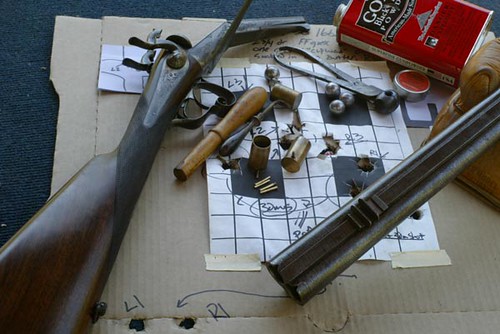| tinker |
| (.416 member) |
| 05/12/08 07:29 AM |

|
|
|
I'll ring back to this on a couple of related points, both on barrels.
My comment, taking H&H as an example, illustrates the differences between modern standard alloy steels (such as Bramble's noted 4140) and the sometimes mysterious steels used in rifle barrels at the turn of the 19/20th century.
Of blown best doubles from back then, the bulk of the stories I've heard have been of as-new safe-queen miracle condition rifles.
Pop.
What happened?
As yet, I don't know of anyone who's done destructive or nondestructive testing of any of those barrel sets to get an engineer's clue to what really happened.
Could it have been fubar alloy?
What was that alloy?
When TIG welding steel, it takes as much energy to puddle the parent and filler material as it does with a torch or any other type of arc. Where TIG works so well is that it's actually a brilliantly HOT method, but the man in control is able to manipulate the process to a very fine margin - that's how you can get the minimal Heat Affected Zone.
That minimal HAZ is not necessarily a good thing, in airframe repair shops, the techs will at times tig instead of torch weld the alloy steel frame tubing, but they will almost ALWAYS follow up with a torch to anneal the area after a TIG weld, to minimize the risk of stress due to the strictly localized HAZ.
Lightweight bicycle frames were once built from straight or taper gauged 4130 tubing, but the industry learned that (as they didn't have the option of annealing the paper-thin TIG welded tubes with a torch without warping) after tens-hundreds of thousands of stress cycles the tubes would crack near the welds.
That industry is responsible for some very neat new steel alloys that are designed specifically to normalize to an ideal property after cooling down from a TIG weld. Columbus and Reynolds did some of the earliest work in that area.
Bramble actually brings up a very good point.
From an engineer's perspective, it's unwise at best to take something like 4140 and weld it to an unknown alloy of steel in such a high-pressure, high-stress cycle, and high-liability product.
Further, there is no welder worth his tungsten who will attempt to park a TIG weld directly against a soft-soldered or hard-soldered joint such as a rib joint or a silvered sleeve joint.
No way Sam.
The inevitable boiling and ionizing of the non-ferrous filler materials would destroy the possibility of a sound weld, sending contamination into the grain structure of the parent materials.
As our friend Mac notes, there is really no need to weld at sleeve seams.
With proper attention to detail and process, with proper finishing (strike,polish,burnish,polish,black) the results are essentially invisible.
There's really no good reason why that couldn't have happened with the droplock rifle seen above here.
Cheers
Tinker